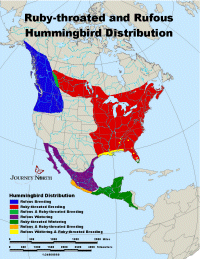 |
 |
||||
|
Hummingbird Migration Update: February 14, 2002
Today's Report Includes:
- Migration News: First Rufous Hummingbirds Reach Oregon
- Tracking Two Species This Spring
- Try This! Compare Rufous and Ruby-throats
- Home on the Range
- Timing is Everything: Challenge Question #1
- Did You Know?
- Hitch Hikers or Not? Most Frequently Asked Question
- Ask the Expert Opens March 1
Migration News: First Rufous Hummingbirds Reach Oregon
Rufous hummingbirds are now arriving along the south and central coast of Oregon! The first official migrant was tallied at Brookings, Oregon on February 5. (Last year's "first" was February 4.) A big thanks to Mr. Mike Patterson of Oregon's Neawanna Wetland Ecological Observatory for sharing Rufous sightings and news with us once again this spring.
 |
Rufous Hummingbird Courtesy of Mike Patterson |
Mike adds, "Anna's Hummingbirds continue to be reported. Individuals were reported gathering spider webs, presumably for nest building, at several locations in Oregon and Washington. In flower news [as of Feb. 4], the manzanita is blooming along the south coast of Oregon, as are ornamental plums. The willows are putting out catkins already in many places along the north coast of Oregon and south coast of Washington." Birds are probably dependent on insects gleaned from willow catkins and beneath leaves in the first few weeks after arrival. But what are catkins?
Be sure to visit Mike Patterson's Web Site, "Hummingbirds
and Flowers," where you can learn more about his study, view an animation
("live" map) of last spring's Rufous Hummingbird migration, and see photos
of flowers that Rufous Hummers like.
Tracking Two Species This Spring
With your help, Journey North is tracking both Rufous hummingbirds and Ruby-throated hummingbirds this spring. These two species have the widest ranges of North American hummingbirds. Ruby-throats are generally seen in the eastern half of the continent and Rufous in the western half. Rufous hummers travel farther north than any hummingbird species. If you're planning to map the migration of this western species, you will need a map that extends all the way to Alaska! Which hummer are YOU watching for: Ruby-throated or Rufous?
Try This! Compare Ruby-Throat and Rufous
These photos will help you see how a Rufous differs from a Ruby-throat. You already know where the first Rufous hummingbird sightings were this spring. What does that information tell you about ONE difference between Rufous hummingbirds and Ruby-throated hummingbirds? But how else are these hummers different? How big are they? What do they eat? Where are the wintering grounds, and what's the climate like there? Where are the breeding grounds? What migration routes do they travel? How far north do these species go? The range map below will help you. Also remember the Journey North Search button on our Web Site. After your investigation, create a Venn diagram to illustrate your findings about these two hummers.
|
|
|
|
Ruby-Throated Hummingbird |
Rufous Hummingbird, Larry & Terrie Gates 1999 |
Home on the Range
- How does the latitude of their wintering areas compare?
- How does the latitude of their breeding areas compare?
- Where do the two species overlap?
Timing is Everything
While Rufous Hummingbirds have been arriving in Oregon since the first week in February, we don't expect Ruby-throated migration sightings so early. Ruby-throats usually arrive around the third week of February, in states along the Gulf Coast like LA, MS, TX, GA, and FL. Why? Give some thought to:
Challenge Question #1:
"Why are Rufous hummingbirds able to begin migrating northward so much earlier than Ruby-throats?"
(To answer this
question, please follow the instructions below.)
Did You Know?
If hummingbirds were as big as ravens, it probably wouldn't be safe to go for a walk in the woods! As you wait for the hummers to return this spring, learn more about these tiny winged wonders. How fast do they fly? How long do they live? How much do they eat? You'll be amazed!
Hitch Hikers or Not? Most Frequently Asked Question
Do hummers hitch a ride on the backs of geese while migrating? We get this question every year. The answer is no. Hummers are fully capable of traveling astounding distances on their own wings. For a long time, people simply didn't believe those tiny Ruby-throated Hummingbirds from northern U.S. and Canada could possibly fly under their own power all the way down to Mexico and Central America. To explain it, they said the hummers must be riding on the backs of bigger birds. The truth is, hummingbirds are so feisty that they often chase and dive-bomb larger birds--even eagles! Perhaps, long ago, someone watched a hummer drop down or come up from dive-bombing a goose and mistakenly thought that the hummer was riding on the goose.
Ask the Expert Opens March 1
Got a Question for the Expert? Your questions are now being accepted for Hummingbird Expert Lanny Chambers. Send them BEFORE the deadline of 5 p.m. (Eastern Time) on March 15, 2002.
How to Respond to Today's Challenge Questions:
IMPORTANT: Answer only ONE question in each e-mail message.
1. Address an e-mail message to: jn-challenge-humm@learner.org
2. In the Subject Line of your message write: Challenge Question #1.
3. In the body of your message, answer the question.
The Next Hummingbird Migration Update Will Be Posted on February
28, 2002.
Copyright 2002 Journey North. All Rights Reserved.
Please send all questions, comments, and suggestions to our feedback form








